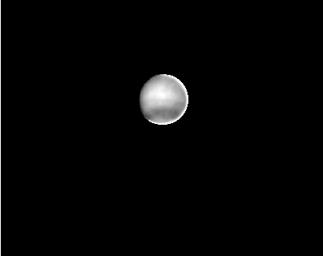
|
Neptune
- Click the image above for a larger view
- Full-Res JPEG (400 x 318) (3.4 kB)
- Full-Res TIFF (400 x 318) (5.4 kB)
Caption:
This image of the planet Neptune was taken by the Voyager 2spacecraft on January 23, 1989, about seven months before its scheduled August 25 encounter. The spacecraft was 310 million kilometers (192 million miles) from the planet, looking from 34 degrees south of Neptune's equator through the "clear" filter. Similar images from Earth-based telescopes had shown a featureless disk, through red filters, chosen to mark methane gas, revealed irregular-shaped features associated with high-altitude hazes. The Voyager data reveal cloud structure at lower altitudes where the circulation is apparently arranged in parallel east-west bands, as is the case on Jupiter, Saturn, and Uranus. In the original image, the bright bands are about 10 percent brighter than the dark band circling the South pole. This is about the same contrast shown by Saturn, and ten times more than Uranus. The brightening and sawtooth edge around the right side are artifacts of the data processing.
Background Info:
The Voyager project is managed by the Jet Propulsion Laboratory for the NASA Office of Space Science and Applications.
Cataloging Keywords:
| Name | Value | Additional Values |
|---|---|---|
| Target | Neptune | Jupiter, Saturn, Uranus |
| System | Neptune | |
| Target Type | Planet | |
| Mission | Voyager | |
| Instrument Host | Cassini Orbiter | Voyager 2 |
| Host Type | Orbiter | Flyby Spacecraft |
| Instrument | Imaging Science Subsystem (ISS) | |
| Detector | ||
| Extra Keywords | Atmosphere, Grayscale, Haze, Methane | |
| Acquisition Date | ||
| Release Date | 1999-08-08 | |
| Date in Caption | 1989-01-23 | |
| Image Credit | NASA/JPL | |
| Source | photojournal.jpl.nasa.gov/catalog/PIA02205 | |
| Identifier | PIA02205 | |
